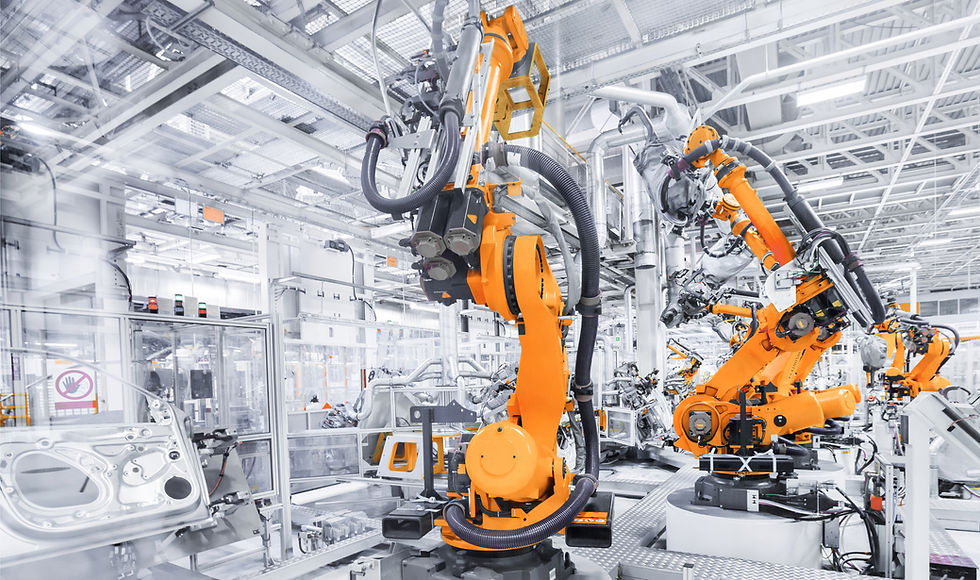Is 3D Printing in Construction The Future of Home building?
- roshanfernando9619
- Apr 17
- 5 min read
Updated: Apr 18
Introduction
In this article we will cover some of my interesting research on this fast emerging industry and growing technologies of 3D printing. When I was younger 3-D printing was seen as futuristic and expensive, now it is the future and affordable in people's houses. You can print off a variety of things including key chains, panels for doors, mugs and other items. You can even sell and share your online designs worldwide.
The automotive industry
I think there are parallels between the automotive industry in the past to the construction industry today. Automotive robots were introduced in the early 1960s and where primarily used for welding and assistance on the assembly line. These machines was successful at lowering inefficiency early on. In modern time assembly robots are used in every part of the car manufacturing process. They are deployed in flexible and stable conditions to help speed and efficiency of the car building process.

Robots and AI are becoming an ever present in both professional and leisure environments. The automotive industry improved a lot from the addition of technology although it started slowly at first, this innovations changed the whole landscape of car manufacturing.
Even though, workers may be reluctant to see robots and technology entering their workplace, overall it benefits the consumers over time if done correctly. Technology has a big role to play in the new housing industry.
Housing and shortages
Currently there is a massive housing shortage around the world not just in western countries, the amount of population growing is not matching the rate of production of new homes. This is large in Nigeria faces a significant housing shortage, with estimates suggesting a deficit of around 20-28 million units. In the city of Berlin the city needs an average of 20,000 new apartments annually to keep up with the increasing population. All across the globe there is a deficit of housing and it is getting larger and with rising rents, urbanisation, and new families growing.

Technology innovation has a great opportunity to create cheaper more affordable houses but also in a quicker production time.
3d printing in general
There are several benefits of 3D printing in general, in bringing manufacturing supply chains closer and tighter circles of production. This would offset the carbon emissions (seen in my previous article) and environmental impacts caused from our day-to-day living. In manufacturing, environmental impacts would be caused from transport, shipping and time taken to redesigning. 3d printing has the opportunity to mitigate this significantly.
In construction
40% of all global emission annually comes from construction industry (GCF 2022). The 3D printing industry has a large potential in medical technology, clean tech and space and aviation industries. The industry is not perfect however in the housing industry the some unique opportunities. There are claims of 3D printing of creating low income housing in less than 48 hours due to its precision and lack of waste. Construction is a industry with a lot of waste and it can be mitigated to lower its carbon emissions. There are many companies that create 3D printed buildings and there is not any standard yet or an 'Apple' company that consumers can see there is a building construction company that prints homes in the public eye. There is a lot of price fluctuations in what is possible in 3D printing a building because there is not a best or ideal way industry method at the moment. There are all smaller international start ups that there is waiting for one to create the gold standard of how buildings are supposed to be 'printed'. Many international governments are there to attempt to find this 'gold' standard start up with a lot of government subsidies going into 3D printing construction companies, most notably in Saudi Arabia and in the UAE.
Here are a few examples.
In Japan
In Japan they appreciate the technology in creating lower cost and speedy houses in terms of earthquake and natural disaster relief to their citizens. A company named "Serendix", claims to create small buildings in a less than 24 hours and for less than $24,000. This is really helpful with their regular tectonic and volcanic activity in this country. Other companies in the US and places see 3D printing as a opportunity to meet humanitarian needs and provide aid for the homeless and in need.

In Kenya
In Kenya, they are struggling with housing deficit greatly in this country. A joint venture between 'Holcim' and '"4Trees" have created the largest 3D printed complex in Africa. "Mvule Gardens" project is a neighbourhood complex made from 52 houses.

In US
Company named Azure have made 3D printed models of home made from recycled plastics.
3D printing has a unique capability to use waste products and create them in to great living spaces.

Pros and Cons of 3D printing in construction
As previously mentioned, there is no industry one size fits all for 3D Printing.
however here are some of the blanket Pros and Cons.
Pros
Faster construction time some companies have claimed that traditional house building can make a family 3 bedroom home in 7 months, whilst 3D printing a home can take 3-4 months. This would give us a massive boost of hope and optimism there could be a ideal production methods using 3D technology in meeting the housing needs globally.
Less waste and less global emissions due to the precise nature of construction.
Less movement in the supply chain, travelling and sourcing of raw materials. This leads to more creative solutions being able to be designed and made on the fly.
Less labour intensive and claims on cheaper to build a home.
Cons
Problems in materials to use for long lasting 3D printing housing designs. There isn't yet a consensus on what building materials in the printers. 3D printers widely use concrete in buildings. How much do we use from the printer and how much can we prefabricate materials also.
To solve our human solutions how much do we rely on machines and how much do we rely on Human capabilities to meet our current global needs.
There is not a combination consensus on methods of using 3d printing and human builders in one way. In the automotive industry in the 1960s, new technology was introduced slowly with menial tasks to then confidently expand into the rest of the processes. In housing it is a naturally decentralised process with every person having their own design needs, therefore its hard to make a 'perfect' of human and machine without a lot of government subsidies.
Moving this equipment round. Usually there is a need for multiple cranes and massive trucks to move an 3D printing unit around. However there are new designs coming out to make this more easier to do.
Job loses if this industry were to be established there would likely be major job loses in the coming 20-30 years.
In conclusion
There is a lot of potential from these advancing technology and new innovation are being found all the time in transport, efficiency and use of materials. Watch this space!!!
Sources:
Financial
3D housing projects
3D manufacturing
.png)


Comments